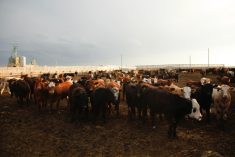Stagnant farm cash receipts against significant increases in feed, fuel and interest costs have led to Canada’s biggest decline in realized net farm income in over a decade.
That’s according to Statistics Canada, which on Tuesday released full-year farm income data for 2018, pegging realized net farm income for the year at $3.9 billion, down 45.1 per cent from 2017, marking the biggest year-over-year drop since 2006. The same number fell just 2.8 per cent in 2017 from 2016.
StatsCan defines “realized net income” as the difference between a farmer’s cash receipts and operating expenses, minus depreciation, plus income in kind — not to be confused with “total net farm income,” defined as realized net income adjusted for changes in farmer-owned inventories of crops and livestock.
Read Also

Alberta crop conditions improve: report
Varied precipitation and warm temperatures were generally beneficial for crop development across Alberta during the week ended July 8, according to the latest provincial crop report released July 11.
Realized net income fell in every province except New Brunswick, StatsCan said, where an increase in cannabis and potato production lifted receipts by 7.2 per cent. More than a third of the Canada-wide decrease stemmed from a 68.1 per cent decline in Alberta alone.
Total net farm income dropped to $3 billion in 2018, decreasing across all provinces, for a national value of $5.2 billion from 2017, mainly on lower on-farm stocks of barley, corn, non-durum wheat and soybeans and lower cattle and calf inventories.
Farm expenses were up in every province, totalling $50.6 billion, up 6.5 per cent from 2017 for the largest percentage increase since 2012.
Feed costs were up 9.6 per cent on tight pre-harvest supplies of feed grains, StatsCan said. Interest expenses rose 19.5 per cent on rising average interest rates, while machinery fuel expenses were up 18.1 per cent and cash wages rose eight per cent from 2017.
Farm cash receipts — crop and livestock revenues and program payments — rose just 0.1 per cent, to $62.2 billion, in 2018. Farm cash receipts were down in five provinces, Alberta falling farthest at four per cent; New Brunswick, Quebec, Ontario and British Columbia saw gains.
Crop revenue rose 0.9 per cent to $35 billion in 2018 on increases in non-durum wheat and cannabis revenues against a 6.5 per cent decline in canola receipts — again, most notably in Alberta, where canola revenue dropped 16.1 per cent. Lentil and dry pea receipts were also down, StatsCan said, mainly on India’s pulse crop tariffs.
Livestock production revenue slipped 0.2 per cent, to $25 billion, in 2018 as hog receipts fell 8.9 per cent on record-high North American inventories. Cattle and calf revenue rose 0.1 per cent on higher marketings against small price decreases.
Q1 receipts
StatsCan on Tuesday also released data on farm cash receipts for the first quarter of 2019, pegging total receipts nationwide at $15.9 billion, up 3.1 per cent from the year-earlier period.
Barring Nova Scotia, Manitoba and Ontario, Q1 farm cash receipts were up by province, most notably in Saskatchewan and Alberta.
Crop receipts for the quarter totalled $9 billion, up 1.5 per cent from the same quarter in 2018, but would have shown a 0.8 per cent decline if cannabis receipts were left out of the equation. Wheat and lentil receipts were also up while canola and soybean receipts dropped.
Livestock receipts in the quarter rose 1.3 per cent to $6.2 billion, mainly on a four per cent increase in cattle receipts and 4.2 per cent increase in dairy receipts, slightly offset by hog receipts down 8.7 per cent.
Higher overall crop insurance payouts during the quarter led to a 60.6 per cent increase in overall program payments. Alberta accounted for just over half of those crop insurance payments, on acres left unharvested due to adverse weather. — Glacier FarmMedia Network















